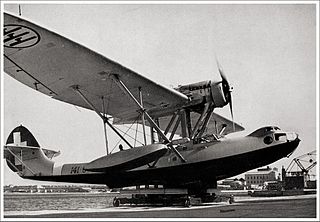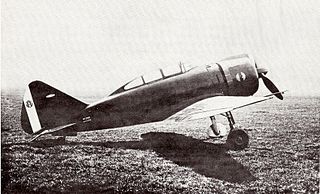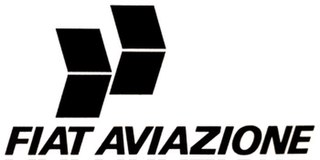Aeronautica Umbra SA was an Italian aircraft manufacturer founded at Foligno in 1935 by Muzio Macchi. The firm produced SM.79 bombers for the Regia Aeronautica but never enjoyed success with its own designs. Its best-known attempt was the AUT.18 fighter of 1936. Another promising prototype, the MB.902 had two Daimler-Benz DB 605 engines within the fuselage, driving contra-rotating propellers mounted on the wings, but this was destroyed without ever having flown.
After World War II, the company reformed and in 1968 commenced work on a design for a three-engine STOL transport aircraft designated the AUM-903. This, however, was never actually built, although the company did manufacture Scheibe Falke under licence for a time.

DASA was a German aerospace manufacturer.

The Caproni Campini N.1, also known as the C.C.2, is an experimental jet aircraft built in the 1930s by Italian aircraft manufacturer Caproni. The N.1 first flew in 1940 and was briefly regarded as the first successful jet-powered aircraft in history, before news emerged of the German Heinkel He 178's first flight a year earlier.
Alenia Aeronautica was an Italian aerospace company. Its subsidiaries included Alenia Aermacchi and Alenia Aeronavali.

Caproni, also known as Società de Agostini e Caproni and Società Caproni e Comitti, was an Italian aircraft manufacturer. Its main base of operations was at Taliedo, near Linate Airport, on the outskirts of Milan.
SIAI-Marchetti was an Italian aircraft manufacturer primarily active during the interwar period.

The Savoia-Marchetti SM.81 Pipistrello was the first three-engine bomber/transport aircraft serving in the Italian Regia Aeronautica. When it appeared in 1935, it represented a real step ahead in Italian military aviation: it was fast, well armed and had a long range. It proved effective during the war with Ethiopia and the Spanish Civil War. Despite being too slow to remain competitive as a bomber in the later years of World War II, it was one of the most flexible, reliable and important aircraft of the Regia Aeronautica from 1935 to 1944, and adapted to second-line duties in a wide range of tasks.

The CANT Z.501 Gabbiano was a high-wing central-hull flying boat, with two outboard floats. It was powered by a single engine installed in the middle of the main-plane and had a crew of 4–5 men. It served with the Italian Regia Aeronautica during World War II, as a reconnaissance aeroplane. During its debut in 1934, it set a world distance record. It was obsolete by 1940, but was still used throughout World War II, suffering many losses. A few remained in service until 1949.

The Savoia-Marchetti S.74 was a four-engine airliner developed by Savoia-Marchetti for Ala Littoria.

The Reggiane Re.2000 Falco I was an Italian all metal, low-wing monoplane developed and manufactured by aircraft company Reggiane. The type was used by the Regia Aeronautica and the Swedish Air Force during the first part of the Second World War.

Compagnia Nazionale Aeronautica was a manufacturer of aircraft and aircraft engines established in Italy in 1920 by Count Giovanni Bonmartini. Together with a group of World War I veteran pilots, he operated a flying school in Rome from a field that would eventually be developed into Littorio airport. For the next decade or so, CNA also developed their own aircraft and engines to power them. Bonmartini had also worked on an advanced racing motorcycle engine, the GBR in another partnership, and eventually CNA acquired the rights to this as well.

SAI Ambrosini was an Italian aircraft manufacturer established in Passignano sul Trasimeno, Italy, in 1922 as the Società Aeronautica Italiana. It became SAI Ambrosini when it was acquired by the Ambrosini group in 1934. Prior to World War II, the firm built a number of light touring and racing aircraft, the most successful of which was the SAI.7. During the war, this design served as the basis for some light fighter designs, but these did not enter mass production.
Officine Meccaniche Reggiane SpA was an Italian industrial manufacturer and aviation company.

Fiat Aviazione was an Italian aircraft manufacturer, at one time part of the Fiat group, focused mainly on military aviation. After World War I, Fiat consolidated several Italian small aircraft manufacturers, like Pomilio and Ansaldo. Most famous were the Fiat biplane fighter aircraft of the 1930s, the Fiat CR.32 and the Fiat CR.42. Other notable designs were the fighters CR.20, G.50, G.55 and a bomber, the Fiat BR.20. In the 1950s, the company designed the G.91 light ground attack plane.

The Macchi MB.308, later Aermacchi MB-308, was a light aircraft produced in Italy in the late 1940s.

Giovanni Battista Caproni, 1st Count of Taliedo, known as "Gianni" Caproni, was an Italian aeronautical engineer, civil engineer, electrical engineer, and aircraft designer who founded the Caproni aircraft-manufacturing company.

The Gianni Caproni Museum of Aeronautics is Italy's oldest aviation museum, as well as the country's oldest corporate museum. It was established in 1927 as the Caproni Museum by Italian aviation pioneer and aeronautical engineer, Giovanni Battista "Gianni" Caproni and his wife, Timina Guasti Caproni.

The Caproni Ca.193 was an Italian liaison and air-taxi aircraft that was offered to the Italian Air Force as an instrument flight trainer and to the Navy for liaison. Design work started in 1945 and only the prototype was built. It was the last aircraft the Caproni company designed and built in Milan.
The Alfa Romeo Avio was an Italian aviation company producing aircraft engines active since 1941. It was founded as a division of Alfa Romeo but was sold to Aeritalia in 1986 and then to Fiat in 1996. It was merged with Fiat Avio in 2003 as Avio S.p.A.

The Macchi M.20 was a single-engine biplane trainer aircraft produced by the Italian aeronautical company Aeronautica Macchi between the end of the 1910s and the beginning of the 1920s.